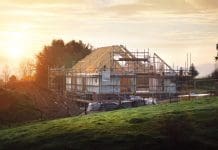New guidance has been published by Historic Environment Scotland, setting out how to safeguard Scotland’s traditional buildings from climate change
Traditional buildings must be protected from the impact of climate change. Now, a new guidance has been released to help safeguard the future of these buildings.
The ‘Climate Change Adaption for Traditional Buildings’ is the latest to be published by Historic Environment Scotland and forms part of a series of short guides.
The document was created in collaboration with Adaptation Scotland and highlights how traditional buildings can be protected for the future and made more resilient to factors associated with climate change.
Within the guide is information and advice describing good practice in maintenance, repair, and how to adapt buildings from increasingly wet winters.
Scotland’s heritage buildings provide a rich historic environment
There are some 450,000 traditionally constructed buildings across Scotland, used for a range of purposes. The guide hopes to provide advice to help homeowners, landlords, as well as building and construction professionals care for these properties.
Roger Curtis, Technical Research Manager at Historic Environment Scotland, said: “Scotland’s built heritage is an important part of the country’s wider historic environment.
“Our climate has already changed over the past 50 years and we expect that further change is inevitable.
“The latest in our Short Guides – Climate Change Adaptation for Traditional Buildings is a great free resource for those who live in or care for traditionally constructed buildings.
“Drawing on technical research into how traditional materials and techniques can be effectively used to improve a structure’s resilience, the guide provides up to date information and advice that can be taken to help secure the future of our traditional buildings in a changing climate.
“Assessing the wide ranging impacts on the historic environment is key and undertaking measures such as adaptation and increasing resilience is a very important part of our broader climate response.”
















